Hammock camping offers a lightweight‚ comfortable alternative to traditional tent camping‚ providing a unique way to connect with nature. Ideal for backpackers and casual campers alike‚ it requires specific gear for a safe and enjoyable experience.
What is Hammock Camping?
Hammock camping is an outdoor activity where campers sleep in a suspended hammock instead of a traditional tent. It involves setting up a hammock between two sturdy trees using suspension systems and straps. Unlike ground camping‚ hammock camping elevates you above the terrain‚ offering a unique perspective and connection with nature. While it requires specific gear‚ such as tarps for rain protection and underquilts for insulation‚ the setup provides a lightweight and immersive way to enjoy the outdoors. Hammock camping is ideal for those seeking adventure and a closer bond with their surroundings.
Benefits of Hammock Camping
Hammock camping offers numerous advantages‚ including reduced weight and bulk compared to traditional tents. It eliminates the need for flat ground‚ making it ideal for uneven terrain. The suspended design improves airflow‚ often leading to better sleep quality. Hammocks also provide a unique connection to nature‚ with unobstructed views of the surroundings. Additionally‚ they minimize environmental impact by avoiding ground compression. With the right gear‚ hammock camping can be more comfortable and freeing‚ offering a refreshing alternative to conventional camping methods while keeping you closer to the natural world.
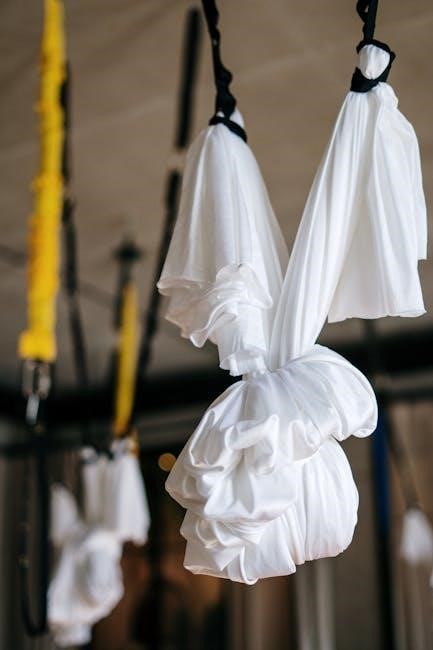
Essential Gear for Hammock Camping
A hammock‚ suspension system‚ tree straps‚ tarp‚ and underquilt are the core components. These ensure comfort‚ protection from the elements‚ and proper insulation for a restful experience.
Hammock Types and Materials
Hammocks come in various styles‚ including DIY‚ ultralight‚ and expedition models. Materials range from durable nylon and polyester to lightweight silk. Fabric blends like ripstop nylon are popular for their strength and resistance to tears. Accessories like bug nets and built-in tarps enhance functionality. Ultralight hammocks are ideal for backpackers‚ while expedition hammocks offer extra durability for harsh conditions. Choosing the right material depends on your needs for weight‚ durability‚ and breathability. Proper selection ensures a comfortable and secure camping experience.
Suspension Systems and Tree Straps
A reliable suspension system is essential for secure hammock setup. Tree straps are wide‚ durable bands that wrap around trees‚ protecting bark while distributing weight evenly. Suspension materials‚ like nylon or polyester‚ are strong and resistant to abrasion. Straps should be at least 1 inch wide to prevent tree damage. Adjustable buckles or knots allow for easy tensioning. Proper suspension ensures a stable and comfortable hang. Always choose straps with tree-friendly designs to minimize environmental impact. A well-designed suspension system enhances safety and ensures a restful camping experience.
Tarp and Rain Protection
A tarp is a crucial piece of gear for hammock camping‚ offering reliable rain and wind protection. Look for waterproof and UV-resistant materials like nylon or polyester. The tarp should be larger than your hammock to ensure full coverage. Setup options include ridge lines and side tie-outs for optimal protection. Choose a tarp with reinforced stitching and sturdy grommets for durability. Properly securing the tarp ensures a dry and comfortable shelter. Always consider the shape and size of the tarp to match your hammock and camping needs. A well-designed tarp enhances safety and comfort in all weather conditions.
Underquilts are essential for maintaining warmth during hammock camping‚ as they provide insulation beneath you. They trap warm air close to your body‚ preventing heat loss to the ground or air. Choose materials like down or synthetic insulation based on weather conditions. Underquilts are designed to be lightweight and compact. Proper adjustment ensures full coverage. Adding a top quilt enhances comfort in colder temperatures. Together‚ these items create a cozy sleeping environment. Always consider the season and expected low temperatures when selecting insulation. A well-insulated setup guarantees a restful night’s sleep. Enhance your hammock camping experience with accessories like bug nets‚ pillows‚ and storage solutions. These items ensure convenience and relaxation‚ making your trip more enjoyable. A good night’s sleep in a hammock requires proper insulation. Sleeping bags and top quilts are essential for maintaining warmth‚ especially in cooler conditions. Choose gear with a comfort rating suitable for your environment. Top quilts offer versatility‚ while sleeping bags provide familiar comfort. Pairing these with an underquilt ensures all-around insulation‚ preventing heat loss and keeping you cozy throughout the night. Investing in quality insulation is crucial for a restful hammock camping experience‚ regardless of the season. Keeping your gear organized is key to a stress-free hammock camping experience. Storage solutions like stuff sacks‚ compression bags‚ and hammock-specific organizers help keep essentials within reach; Consider using a gear sling or ridgeline organizer to store small items like snacks‚ headlamps‚ and toiletries. Waterproof bags protect your belongings from moisture‚ while compression sacks save space in your backpack. Efficient storage ensures your camp remains tidy and functional‚ allowing you to focus on enjoying nature. Proper organization also makes setting up and breaking down camp quicker and more efficient. Enhance your hammock camping experience with accessories designed for comfort. A bug net protects you from insects‚ while an underquilt and top quilt provide insulation for colder nights. A compressible pillow ensures proper neck support‚ and gear slings keep essentials like snacks and headlamps within easy reach. Adding a small stool or table can also improve convenience‚ serving as a place to set drinks or gear. These accessories not only boost comfort but also elevate the overall enjoyment of your hammock camping adventure‚ making it feel more like home away from home. Properly chosen‚ they enhance relaxation and convenience in nature. Setting up your hammock involves finding sturdy trees 10-15 feet apart‚ securing straps at a 30-degree angle‚ and using a groundcloth for protection against wet or uneven terrain. Choosing the right trees is crucial for a safe hammock setup. Look for sturdy trees that are 10-15 feet apart with trunks at least 4 inches in diameter. Avoid trees with signs of decay or weak branches. Ensure the trees are healthy and can support your weight. The ideal distance between the trees allows for proper hammock suspension without over-tightening the straps. Also‚ consider the surrounding area to avoid obstacles like rocks or overhanging branches. Proper tree selection ensures a secure and comfortable camping experience. Always inspect the trees before setting up your hammock. Properly adjusting the hammock angle is key for comfort and safety. Aim for a 30-degree angle between the straps and the ground for optimal support. A flatter angle provides a more bed-like feel‚ while a steeper angle creates a reclined position. Experiment with the suspension to find your preferred lay. Ensure the hammock isn’t too tight‚ as this can cause discomfort‚ or too loose‚ which may lead to sagging. Adjustments may be needed based on your weight distribution and personal preference. Proper angling ensures a restful and enjoyable camping experience. Always test the setup before finalizing it. Securing your hammock properly ensures safety and comfort. Start by attaching the suspension system to sturdy trees‚ using wide‚ tree-friendly straps to protect the bark. Adjust the straps to achieve the desired height and tension‚ ensuring the hammock is level. Tighten the suspension evenly to avoid sagging or unevenness. Use a rainfly or tarp for weather protection‚ securing it with stakes and guy lines. Always test the setup by gently tugging on the hammock to ensure stability. Proper securing prevents accidents and ensures a restful camping experience. Double-check all knots and connections before use. Always use tree-friendly straps to avoid harming the environment. Keep a safe distance from hazards like cliffs or standing water. Protect yourself from insects with bug nets and repellents. Ensure your campsite remains clean‚ and follow Leave No Trace principles to preserve nature. Properly secure your gear to prevent damage from wind or wildlife. Be mindful of local regulations and weather conditions for a safe and eco-friendly hammock camping experience. Respect the natural surroundings to ensure a sustainable adventure. Always prioritize safety and environmental care. Minimize your footprint for future campers. Stay prepared for emergencies with a first-aid kit and communication tools. Check the weather forecast to avoid unexpected storms. Keep food and trash secure to avoid attracting wildlife. Be aware of your surroundings and potential hazards like falling branches or uneven terrain. Educate yourself on local wildlife and plant life to avoid harmful interactions. Use biodegradable products and pack out all waste. Avoid camping in sensitive or protected areas. Stay informed about local fire restrictions and fully extinguish any campfires. Respect private property and obtain necessary permits. Ensure your hammock setup is stable and secure to prevent accidents. Stay visible and let someone know your camping plans. Bring essential safety gear like a whistle and flashlight. Keep your campsite tidy to reduce the risk of attracting pests. Enjoy nature responsibly and leave the environment as you found it. Always be prepared for changing conditions and emergencies. By following these guidelines‚ you can enjoy a safe and environmentally conscious hammock camping trip. Remember‚ safety and nature preservation go hand in hand. Protecting yourself from bugs is essential for a comfortable hammock camping experience. Use a bug net designed for hammocks‚ such as those offered by ENO‚ to keep insects at bay. Apply insect repellent containing DEET or picaridin to exposed skin and clothing. Wear long sleeves and pants during peak bug hours. Consider treating your gear with permethrin for added protection. A bug net with a fine mesh can prevent even the smallest insects from reaching you. Remember to seal any gaps in your hammock setup to ensure complete coverage. Don’t forget to check for ticks after spending time outdoors. Stay bug-free and enjoy your camping trip. Minimizing environmental impact is crucial when hammock camping. Always use tree-friendly straps to avoid damaging trees. Choose campsites with durable surfaces and avoid sensitive habitats. Pack out all trash and leave no trace. Use biodegradable soap for washing and keep campfires small or opt for a portable stove. Lightweight gear helps reduce your footprint‚ and reusable items like water bottles and cloths are eco-friendly. Respect wildlife by storing food properly and avoiding feeding animals. By being mindful of your surroundings‚ you can enjoy nature while preserving it for future generations. Keep the outdoors pristine for everyone to enjoy. Stay eco-conscious and camp responsibly. Hammock camping offers a unique‚ immersive outdoor experience‚ combining comfort with nature. With the right gear and setup‚ it provides a restful and memorable adventure in the wilderness. For a memorable hammock camping trip‚ always research your location beforehand and test your gear at home. Arrive early to secure the best trees and ensure proper setup. Use wide‚ tree-friendly straps to protect the environment. Keep your gear dry by securely attaching your tarp‚ and store essentials within easy reach. Start with short trips to build confidence and gradually expand your adventures. Remember to minimize your environmental footprint by leaving no trace. With practice‚ you’ll master the art of hammock camping and enjoy the serene beauty of nature like never before.Underquilts and Insulation
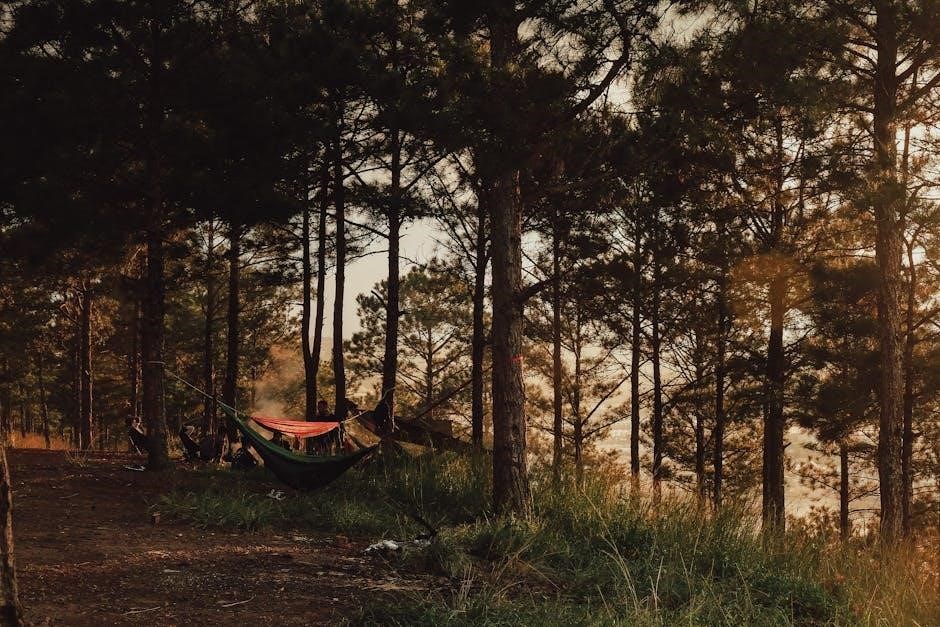
Additional Gear for Comfort
Sleeping Bags and Top Quilts
Storage Solutions for Gear
Accessories for Enhanced Comfort
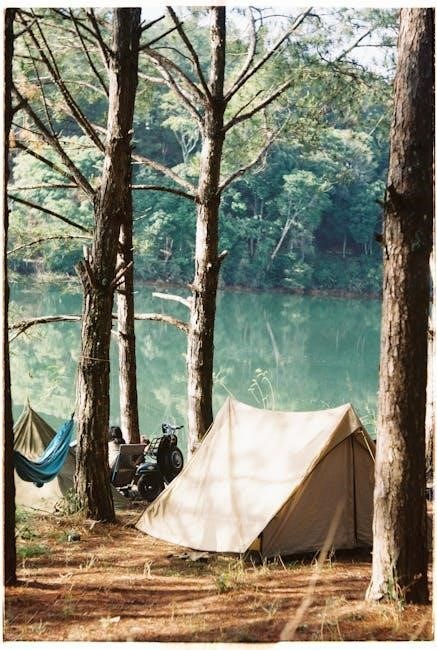
Setting Up Your Hammock
Choosing the Right Trees
Adjusting the Hammock Angle
Securing the Hammock Properly

Safety and Environmental Considerations
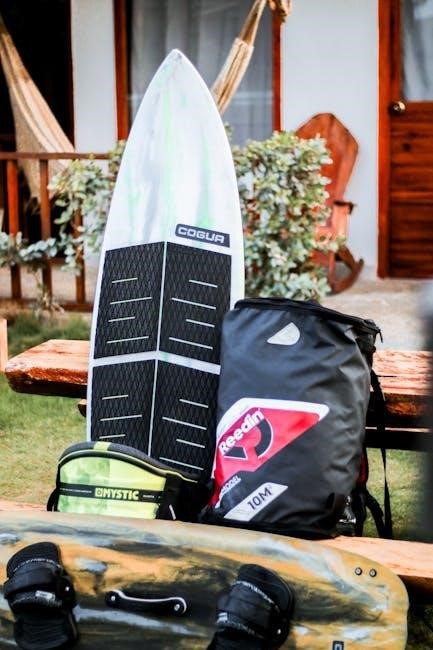
Protecting Yourself from Bugs
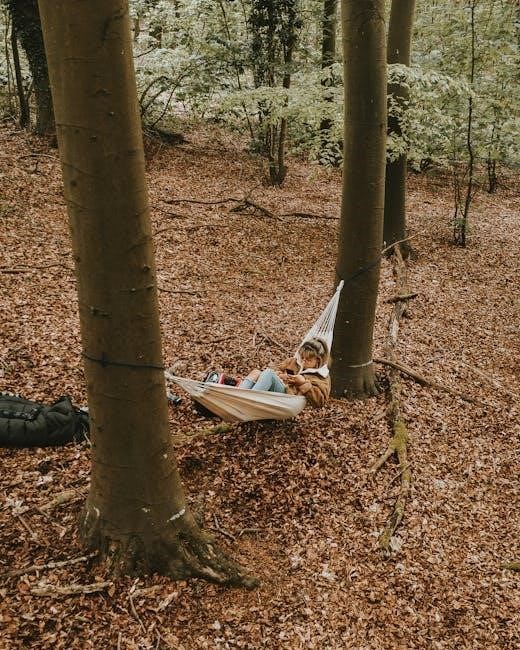
Minimizing Environmental Impact
Final Tips for a Successful Hammock Camping Experience
